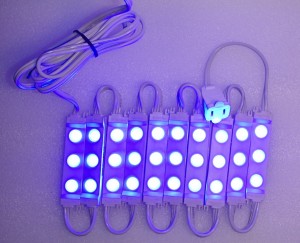LEDs for Seasonal Affective Disorder
/in Health & Well Being /by Darryl NelsonLEDs for Seasonal Affective Disorder
Seasonal affective disorder has not been long recognized as an official diagnosis. SAD was a term that first started appearing in print in 1985 and started to become more and more prominent as something that Medical doctors and Naturopathic doctors diagnosed.
SAD, Winter Blues, Winter Depression or otherwise known as Seasonal Depression is a  type of depression that occurs during the same season each year. You may have SAD if you felt depressed during the last two winters but felt much better in spring and summer. In most cases the symptoms are more intense during the darkest months.
type of depression that occurs during the same season each year. You may have SAD if you felt depressed during the last two winters but felt much better in spring and summer. In most cases the symptoms are more intense during the darkest months.
Some of the treatments for SAD may include psychotherapy, medications and light therapy, otherwise known as phototherapy. Light therapy is one of the treatments that offers low cost, it’s the least invasive and promotes the most natural and immediate response. You should feel a difference within yourself over the period of a week with daily use.
“Light therapy or phototherapy (classically referred to as heliotherapy) which basically is used in conjunction with exposure to daylight or to specific wavelengths of light using polychromatic polarized light.”
The benefits of SAD lights have been documented in vast medical studies and include results that provide more than just relief for Seasonal Affective Disorder. SAD lamps have been shown to increase energy, ease depression and even help regulate the internal body clock.
There are a variety of people who get SAD including but not limited to:
• Both genders, all ages
• People who live far from the equator
• People who have a close relative with SAD
• People who react adversely to the decreasing amounts of naturally occurring light
• People who are on ‘shift work or continental shifts’
• Circadian rhythm disorders
• Delayed sleep phase disorder
• Some data also suggests that light therapy can be used for non-seasonal psychiatric disorders and mood disorders
There are those who suffer from this condition during various seasons of the year and this relatively depends upon environmental and habitual conditions.
• You may have trouble concentrating
• Sleep more but still feel tired
• Reduced libido
• You may gain weight with the onset of SAD
• You may eat more and crave carbohydrates, such as bread and pasta
• You may lose interest in your usual activities
• You may feel sad, grumpy, moody, or anxious
Currently there are multiple clinical trials and research papers being conducted regarding the benefits of light therapy. The research is showing that light therapy is helping people regain a sense of balance with…
• ADHD (eased the symptoms, improved functioning, and reduces symptoms of anxiety/depression)
• Alzheimer’s Disease (Blue light therapy helps through regulation of sleep patterns)
• Bulimia Nervosa (a psychological eating disorder that is characterized by episodes of binge eating)
• Chronotherapy (treatment scheduling)
• Chronic Fatigue Syndrome (long term fatigue) persists for more than 6 month accompanied by cognitive disorders
• Circadian rhythm disorder (physical, mental and behavioral changes that follow a roughly 24-hour cycle)
• Fibromyalgia (Reestablishing consistent deep restorative sleep is the key for reversing your chronic fibromyalgia symptoms)
• Major Depression
• Parkinson’s (Blue light helps with symptoms of fatigue)
• Post-Traumatic Stress Disorder (PTSD)- improving cognitive or behavioral functions
• Pre-Menstrual Syndrome (PMS)
• Seasonal Depression
• Sleep disorders,
• Treatment of skin disorders, such as psoriasis, acne vulgaris, eczema and neonatal jaundice.
Symptoms vary from one person to the next, as such the symptoms come and go at about the same time each year. Most people with SAD start to have symptoms in September or October and feel better by April or May.
There are a variety of reason why people get SAD including but not limited to:
• When winter daylight hours are very short
• Lack of sunlight
• Imbalanced serotonin levels
Sometimes SAD lights come in small packages, shapes and sizes and for the smaller blue light sources we recommend the CityLink (Blue), which is a lightweight and easy to use, no flicker LED light source that emits light that is at a lower lux level than light boxes. A bonus to using LED technology is that there is no annoying buzzing sound when the lamp is in operation and also there is almost no heat involved.
The CityLink (Blue) will enable you to sit in a close vicinity of the Blue light source as it is designed with flexibility to emit light at a lower intensity of specific wavelengths in the region of 430-450nm blue. It is a convenient and safe way to enjoy the benefits of light therapy right in your own home.
The best key factor for health and wellness is prevention, therefore the use of Blue light as a therapy is of preventative care. You can avoid the onset and progression of SAD by the use of a supplemental light source which resides at the optimal wavelength of 430-450nm. SAD lamps have been shown to increase energy, ease depression and even help regulate the internal body clock also helping you with your nightly sleeping routine.
There are a few key factors that differ from one SAD light product to another. When considering your living arrangements and where you may plan to treat yourself you should consider ‘Intensity’. Intensity plays a role in your product selection, when you may want to place your light source farther away from where you relax you may want to consider a light of greater magnitude that will emit a higher ‘lux’ level.
There are various types of ‘light boxes’ on the market which require you to distance yourself from the light source because they are of a very high ‘lux’ level.
While there are many SAD lamps available on the market today, it is important to choose a SAD lamp that will meet your specific needs. Should you feel more comfortable sitting at a distance from your blue light source or if this is simply just a better option for convenience, we would like to introduce you to a few of the JUST LED US LED light models which emit high ‘lux’ levels which allows for the user to sit at a greater distance from the light source. Introducing the JUST LED US Medium sized SAD Lamp HYG01-1x96w-w which only pulls 43 watts at the wall.
This is a great lamp for single person use.
Should you prefer a lamp for multiple people to use at the same time please check out the JUST LED US Large sized SAD Lamps starting with the HYG01-2x96w (85 watt) or the  HYG02-2x96w (86.5 watt). All three of these lamps are classified as ‘High lux’ which reach 10 000 + Lux. The HYG01-2x96w and the HYG02-2x96w are double module lamps which easily perform at an affixed overhead height/distance allowing you to complete your morning tasks and breakfast routine and is a convenient and safe way to enjoy the benefits of light therapy right in your own home.
HYG02-2x96w (86.5 watt). All three of these lamps are classified as ‘High lux’ which reach 10 000 + Lux. The HYG01-2x96w and the HYG02-2x96w are double module lamps which easily perform at an affixed overhead height/distance allowing you to complete your morning tasks and breakfast routine and is a convenient and safe way to enjoy the benefits of light therapy right in your own home.
The JUST LED US SAD lamps come with a full 90 day money back Guarantee, they are also backed by a 2 year manufacturer’s warranty also, JUST LED US offers an ‘Extended Warranty’.
Once you have your SAD light it is recommended that you…
• Do not stare (look) directly into the light source
• Have the light within 2′ for best therapeutic value (always refer to specific product recommendations)
• Use it in the morning hours just after waking
• Wake up a few minutes early, or give yourself a few minutes of time before you get out of bed
• You will know within a week or so if it is helping. That is the beauty of the lights. They actually work relatively quickly.
• Do not overdo it; using your light for more than a half an hour a day can adversely affect you circadian rhythm.
• If you have a degenerative eye disease like glaucoma, cataracts, retinal detachment, retinopathy and if you are at risk for diabetes please consult with your optometrist or ophthalmologist as to whether or not this product would be safe for you to use.
• Make sure the light you are researching does not have any sources of UV as it causes progressive damage to human skin.
• People who have sensitive eyes or skin should not use light therapy without first consulting a doctor
• Side effects from light therapy are rare. It can include jitteriness, eyestrain and/or headache, nausea. You can relieve these side effects by decreasing the amount of time you spend under the light


